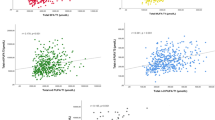Abstract
The fatty acid composition of serum phospholipids was analysed by gas chromatography in 26 non-allergic and 32 allergic mothers at the time of delivery. In 47 of them the levels were compared with those in the cord blood of their babies. The children were then followed for 6 years with regard to the development of allergic disease. There was an inverse relationship between the levels of linoleic acid (LA, C18:2n-6) and its metabolic products arachidonic acid (AA, C20:4n-6) (r = −0.63, P < 0.001), and C22:4 (r = −0.50, P < 0.01) in the non-allergic, but not in allergic mothers (r = 0.25 and r = −0.39, respectively). Comparing the fatty acid levels in maternal and umbilical cord serum, a significant correlation was observed between the LA levels in serum of non-allergic mothers and their babies (r = 0.53, P < 0.05). Furthermore, the maternal dihomo-γ-linolenic acid (DHGLA, C20:3n-6) levels correlated with the cord serum levels of AA (r = 0.65, P < 0.01) and C22:4 (r = 0.65, P < 0.01) and with docosahexaenoic acid (DHA, C22:6n-3, r = 0.65, P < 0.01). None of these relationships were seen when comparing the fatty acid levels in the allergic mothers and their babies. In the mothers of children who did not develop any allergic manifestations during the first 6 years of life, the AA levels correlated with C22:4 (r = 0.53, P < 0.001) and eicosapentaenoic acid (EPA, C20:5n-3) (r = 0.56, P < 0.001). Similar findings were recorded within the n-3 series of fatty acids, i.e. the levels of docosapentaenoic acid (DPA, C22:5n-3) correlated with DHA (r = 0.61, P < 0.001). None of these correlations were significant in the 20 mothers whose babies developed allergic disease (r = 0.42, 0.28 and 0.44 respectively). Taken together, the findings indicate that there is an abnormal metabolism relationship between some of the long-chain polyunsaturated fatty acids in allergic mothers, affecting their infants. Furthermore, the findings suggest an association between the fatty acid composition in maternal serum and the appearance of allergic disease in their children during the first 6 years of life.
Conclusion The proportions of various long-chain polyunsaturated fatty acids were altered in the serum phospholipids of allergic pregnant mothers and in mothers whose babies developed allergic disease over the first 6 years of life, indicating that atopy is associated with a disturbed fatty acid metabolism.
Similar content being viewed by others
Author information
Authors and Affiliations
Additional information
Received: 6 February 1996 and in revised form: 5 August 1997 / Accepted: 5 September 1997
Rights and permissions
About this article
Cite this article
Yu, G., Björkstén, B. Serum levels of phospholipid fatty acids in mothers and their babies in relation to allergic disease. Eur J Pediatr 157, 298–303 (1998). https://doi.org/10.1007/s004310050815
Issue Date:
DOI: https://doi.org/10.1007/s004310050815




